Flume案例和Flume监控系统的使用:
安装
- 将apache-flume-1.7.0-bin.tar.gz上传到linux的/opt/software目录下
-
解压apache-flume-1.7.0-bin.tar.gz到/opt/module/目录下
[hadoop@datanode1 software]$ tar -zxf apache-flume-1.7.0-bin.tar.gz -C /opt/module/
3. 修改apache-flume-1.7.0-bin的名称为flume
[hadoop@datanode1 module]$ mv apache-flume-1.7.0-bin flume
将flume/conf下的flume-env.sh.template文件修改为flume-env.sh,并配置flume-env.sh文件
[hadoop@datanode1 module]$ mv flume-env.sh.template flume-env.sh [hadoop@datanode1 module]$ vi flume-env.sh export JAVA_HOME=/opt/module/jdk1.8.0_162
案例实操
监控端口数据
案例需求:首先,Flume监控本机44444端口,然后通过telnet工具向本机44444端口发送消息,最后Flume将监听的数据实时显示在控制台。
判断端口是否被占用
sudo netstat -tunlp | grep 44444
功能描述:netstat命令是一个监控TCP/IP网络的非常有用的工具,它可以显示路由表、实际的网络连接以及每一个网络接口设备的状态信息。
基本语法:netstat [选项]
选项参数:
-t或—tcp:显示TCP传输协议的连线状况;
-u或—udp:显示UDP传输协议的连线状况;
-n或—numeric:直接使用ip地址,而不通过域名服务器;
-l或—listening:显示监控中的服务器的Socket;
-p或—programs:显示正在使用Socket的程序识别码和程序名称;
配置
hadoop@datanode1 job]$ vim flume-telnet-logger.conf # Name the components on this agent a1.sources = r1 #r1:表示a1的输入源 a1.sinks = k1 #k1表示a1的输出目的地 a1.channels = c1 #C1表示a1的缓冲区 # Describe/configure the source a1.sources.r1.type = netcat #表示a1的输入源类型为netcat类型 a1.sources.r1.bind = localhost #标识a1的监听的主机 a1.sources.r1.port = 44444 #标识a1监听的端口号 # Describe the sink a1.sinks.k1.type = logger #标识a1的输出目的地是logger类型 # Use a channel which buffers events in memory a1.channels.c1.type = memory #表示a1的channel类型是memory内存型 a1.channels.c1.capacity = 1000 #表示a1的channel总容量1000 a1.channels.c1.transactionCapacity = 100 #表示a1的channel传输总容量100 # Bind the source and sink to the channel a1.sources.r1.channels = c1 #表示将r1和c1连接起来 a1.sinks.k1.channel = c1 #表示将k1和c1连接起来
启动
[hadoop@datanode1 flume]$ bin/flume-ng agent --conf conf/ --name a1 --conf-file job/flume-telnet-logger.conf -Dflume.root.logger=INFO,console 参数说明: --conf conf/ :表示配置文件存储在conf/目录 --name a1 :表示给agent起名为a1 --conf-file job/flume-telnet.conf :flume本次启动读取的配置文件是在job文件夹下的flume-telnet.conf文件。 -Dflume.root.logger==INFO,console :-D表示flume运行时动态修改flume.root.logger参数属性值,并将控制台日志打印级别设置为INFO级别。
日志级别包括:log、info、warn、error。
telnet localhost 44444

实时读取本地文件到HDFS案例
测试脚本
[hadoop@datanode1 data]$ vim test.sh #!bin/bash i=1 while [ true ] let i+=1 d=$( date +%Y-%m-%d %H:%M:%S ) do echo "data:$d $i" done
flume-file-hdfs.conf
[hadoop@datanode1 job]$ vim flume-file-hdfs.conf # Name the components on this agent a2.sources = r2 a2.sinks = k2 a2.channels = c2 # Describe/configure the source a2.sources.r2.type = exec a2.sources.r2.command = tail -F /opt/module/flume/job/data/data1.log a2.sources.r2.shell = /bin/bash -c # Describe the sink a2.sinks.k2.type = hdfs a2.sinks.k2.hdfs.path = hdfs://datanode1:9000/flume/%Y%m%d/%H #上传文件的前缀 a2.sinks.k2.hdfs.filePrefix = logs- #是否按照时间滚动文件夹 a2.sinks.k2.hdfs.round = true #多少时间单位创建一个新的文件夹 a2.sinks.k2.hdfs.roundValue = 1 #重新定义时间单位 a2.sinks.k2.hdfs.roundUnit = hour #是否使用本地时间戳 a2.sinks.k2.hdfs.useLocalTimeStamp = true #积攒多少个Event才flush到HDFS一次 a2.sinks.k2.hdfs.batchSize = 1000 #设置文件类型,可支持压缩 a2.sinks.k2.hdfs.fileType = DataStream #多久生成一个新的文件 a2.sinks.k2.hdfs.rollInterval = 600 #设置每个文件的滚动大小 a2.sinks.k2.hdfs.rollSize = 134217700 #文件的滚动与Event数量无关 a2.sinks.k2.hdfs.rollCount = 0 #最小冗余数 a2.sinks.k2.hdfs.minBlockReplicas = 1 # Use a channel which buffers events in memory a2.channels.c2.type = memory a2.channels.c2.capacity = 1000 a2.channels.c2.transactionCapacity = 100 # Bind the source and sink to the channel a2.sources.r2.channels = c2 a2.sinks.k2.channel = c2

实时读取目录文件到HDFS案例
需求分析
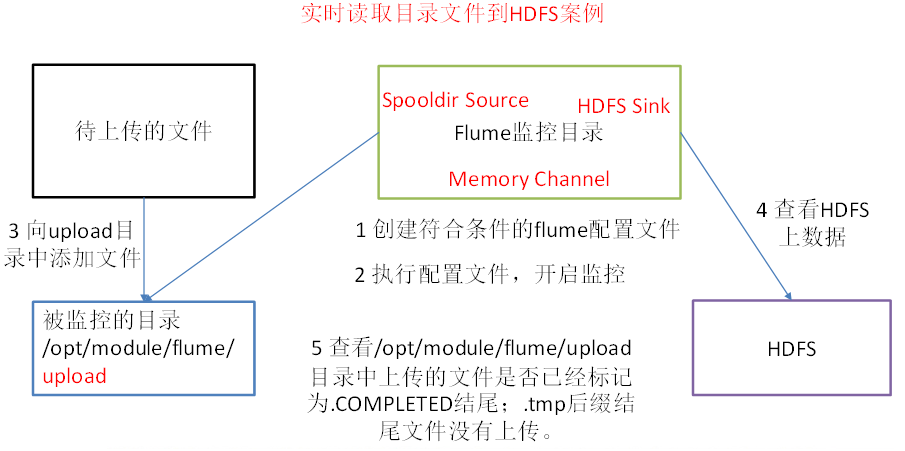
配置
[hadoop@datanode1 job]$ vim flume-dir-hdfs.conf [hadoop@datanode1 job]$ vim flume-dir-hdfs.conf a3.sources = r3 a3.sinks = k3 a3.channels = c3 # Describe/configure the source a3.sources.r3.type = spooldir a3.sources.r3.spoolDir = /opt/module/flume/upload a3.sources.r3.fileSuffix = .COMPLETED a3.sources.r3.fileHeader = true #忽略所有以.tmp结尾的文件,不上传 a3.sources.r3.ignorePattern = ([^ ]*.tmp) # Describe the sink a3.sinks.k3.type = hdfs a3.sinks.k3.hdfs.path = hdfs://datanode1:9000/flume/upload/%Y%m%d/%H #上传文件的前缀 a3.sinks.k3.hdfs.filePrefix = upload- #是否按照时间滚动文件夹 a3.sinks.k3.hdfs.round = true #多少时间单位创建一个新的文件夹 a3.sinks.k3.hdfs.roundValue = 1 #重新定义时间单位 a3.sinks.k3.hdfs.roundUnit = hour #是否使用本地时间戳 a3.sinks.k3.hdfs.useLocalTimeStamp = true #积攒多少个Event才flush到HDFS一次 a3.sinks.k3.hdfs.batchSize = 100 #设置文件类型,可支持压缩 a3.sinks.k3.hdfs.fileType = DataStream #多久生成一个新的文件 a3.sinks.k3.hdfs.rollInterval = 600 #设置每个文件的滚动大小大概是128M a3.sinks.k3.hdfs.rollSize = 134217700 #文件的滚动与Event数量无关 a3.sinks.k3.hdfs.rollCount = 0 #最小冗余数 a3.sinks.k3.hdfs.minBlockReplicas = 1 # Use a channel which buffers events in memory a3.channels.c3.type = memory a3.channels.c3.capacity = 1000 a3.channels.c3.transactionCapacity = 100 # Bind the source and sink to the channel a3.sources.r3.channels = c3 a3.sinks.k3.channel = c3
测试脚本
#!bin/bash i=1 cd /opt/module/flume/upload while [ true ] let i+=1 d=$( date +%Y-%m-%d %H:%M:%S ) do touch "文档$i.txt" touch "$d-$i.log" touch "$i.tmp" sleep 1 done
启动
[hadoop@datanode1 flume]$ bin/flume-ng agent --conf conf/ --name a3 --conf-file job/flume-dir-hdfs.conf
注意
- 在使用Spooling Directory Source时
- 不要在监控目录中创建并持续修改文件
- 上传完成的文件会以.COMPLETED结尾
- 被监控文件夹每600毫秒扫描一次文件变动
查看

查看本地文件

单数据源多出口案例(一)

分析
案例需求:使用flume-1监控文件变动,flume-1将变动内容传递给flume-2,flume-2负责存储到HDFS。同时flume-1将变动内容传递给flume-3,flume-3负责输出到local filesystem。
需求分析:

步骤
-
在/opt/module/flume/job目录下创建group1文件夹
[hadoop@datanode1 job]$ cd group1/
在datanode3节点上/opt/module/datas/目录下创建flume3文件夹
[hadoop@datanode3 datas]$ mkdir flume3/
配置1个接收日志文件的source和两个channel、两个sink,分别输送给flume-flume-hdfs和flume-flume-dir。
datanode1配置文件
[hadoop@datanode1 group1]$ vim flume-file-flume.conf # Name the components on this agent a1.sources = r1 a1.sinks = k1 k2 a1.channels = c1 c2 # 将数据流复制给多个channel a1.sources.r1.selector.type = replicating # Describe/configure the source a1.sources.r1.type = exec a1.sources.r1.command = tail -F /opt/module/datas/logs.log a1.sources.r1.shell = /bin/bash -c # Describe the sink a1.sinks.k1.type = avro a1.sinks.k1.hostname = datanode2 a1.sinks.k1.port = 4141 a1.sinks.k2.type = avro a1.sinks.k2.hostname = datanode3 a1.sinks.k2.port = 4142 # Describe the channel a1.channels.c1.type = memory a1.channels.c1.capacity = 1000 a1.channels.c1.transactionCapacity = 100 a1.channels.c2.type = memory a1.channels.c2.capacity = 1000 a1.channels.c2.transactionCapacity = 100 # Bind the source and sink to the channel a1.sources.r1.channels = c1 c2 a1.sinks.k1.channel = c1 a1.sinks.k2.channel = c2
datanode2配置文件
[hadoop@datanode2 group1]$ vim flume-flume-hdfs.conf # Name the components on this agent a2.sources = r1 a2.sinks = k1 a2.channels = c1 # Describe/configure the source a2.sources.r1.type = avro a2.sources.r1.bind = datanode2 a2.sources.r1.port = 4141 # Describe the sink a2.sinks.k1.type = hdfs a2.sinks.k1.hdfs.path = hdfs://datanode1:9000/flume2/%Y%m%d/%H #上传文件的前缀 a2.sinks.k1.hdfs.filePrefix = flume2- #是否按照时间滚动文件夹 a2.sinks.k1.hdfs.round = true #多少时间单位创建一个新的文件夹 a2.sinks.k1.hdfs.roundValue = 1 #重新定义时间单位 a2.sinks.k1.hdfs.roundUnit = hour #是否使用本地时间戳 a2.sinks.k1.hdfs.useLocalTimeStamp = true #积攒多少个Event才flush到HDFS一次 a2.sinks.k1.hdfs.batchSize = 100 #设置文件类型,可支持压缩 a2.sinks.k1.hdfs.fileType = DataStream #多久生成一个新的文件 a2.sinks.k1.hdfs.rollInterval = 600 #设置每个文件的滚动大小大概是128M a2.sinks.k1.hdfs.rollSize = 134217700 #文件的滚动与Event数量无关 a2.sinks.k1.hdfs.rollCount = 0 #最小冗余数 a2.sinks.k1.hdfs.minBlockReplicas = 1 # Describe the channel a2.channels.c1.type = memory a2.channels.c1.capacity = 1000 a2.channels.c1.transactionCapacity = 100
datanode3配置文件
[hadoop@datanode3 group1]$ vim flume-flume-dir.conf me the components on this agent a3.sources = r1 a3.sinks = k1 a3.channels = c2 # Describe/configure the source a3.sources.r1.type = avro a3.sources.r1.bind = datanode3 a3.sources.r1.port = 4142 # Describe the sink a3.sinks.k1.type = file_roll a3.sinks.k1.sink.directory = /opt/module/datas/flume3 # Describe the channel a3.channels.c2.type = memory a3.channels.c2.capacity = 1000 a3.channels.c2.transactionCapacity = 100 # Bind the source and sink to the channel a3.sources.r1.channels = c2 a3.sinks.k1.channel = c2启动
启动
datanode1
[hadoop@datanode1 flume]$ bin/flume-ng agent --conf conf/ --name a1 --conf-file job/group1/flume-file-flume.conf
datanode2
[hadoop@datanode2 flume]$ bin/flume-ng agent --conf conf/ --name a2 --conf-file job/group1/flume-flume-hdfs.conf
datanode3
[hadoop@datanode3 flume]$ bin/flume-ng agent --conf conf/ --name a3 --conf-file job/group1/flume-flume-dir.conf
单数据源多出口案例(二)
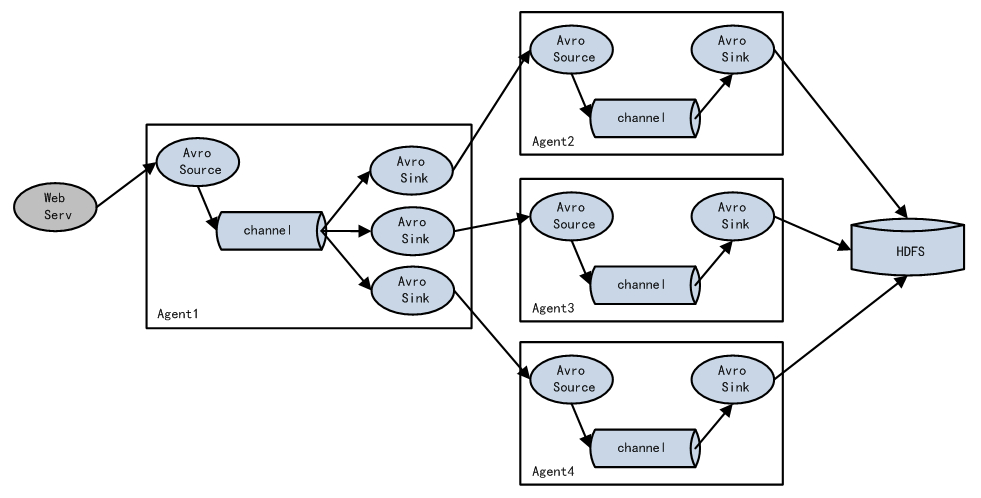
需求
案例需求:使用flume-1监控文件变动,flume-1将变动内容传递给flume-2,flume-2负责存储到HDFS。同时flume-1将变动内容传递给flume-3,flume-3也负责存储到HDFS
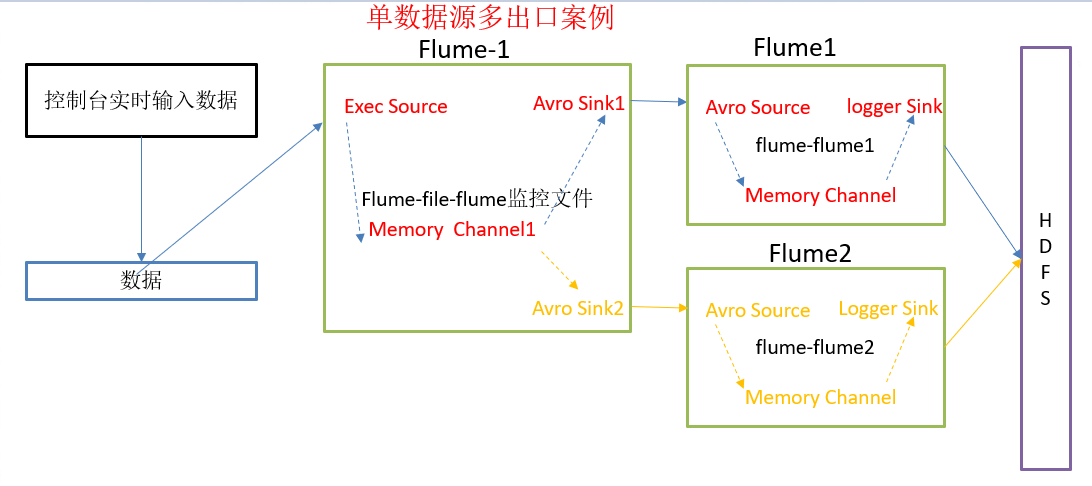
实现
datanode1
[hadoop@datanode1 flume]$ vim job/group1/flume-netcat-flume.conf # Name the components on this agent a1.sources = r1 a1.channels = c1 a1.sinkgroups = g1 a1.sinks = k1 k2 # Describe/configure the source a1.sources.r1.type = netcat a1.sources.r1.bind = datanode1 a1.sources.r1.port = 44444 a1.sinkgroups.g1.processor.type = load_balance a1.sinkgroups.g1.processor.backoff = true a1.sinkgroups.g1.processor.selector = round_robin a1.sinkgroups.g1.processor.selector.maxTimeOut=10000 # Describe the sink a1.sinks.k1.type = avro a1.sinks.k1.hostname = datanode2 a1.sinks.k1.port = 4141 a1.sinks.k2.type = avro a1.sinks.k2.hostname = datanode3 a1.sinks.k2.port = 4142 # Describe the channel a1.channels.c1.type = memory a1.channels.c1.capacity = 1000 a1.channels.c1.transactionCapacity = 100 # Bind the source and sink to the channel a1.sources.r1.channels = c1 a1.sinkgroups.g1.sinks = k1 k2 a1.sinks.k1.channel = c1 a1.sinks.k2.channel = c1
datanode2
# Name the components on this agent a2.sources = r1 a2.sinks = k1 a2.channels = c1 # Describe/configure the source a2.sources.r1.type = avro a2.sources.r1.bind = datanode2 a2.sources.r1.port = 4141 # Describe the sink a2.sinks.k1.type = logger # Describe the channel a2.channels.c1.type = memory a2.channels.c1.capacity = 1000 a2.channels.c1.transactionCapacity = 100 # Bind the source and sink to the channel a2.sources.r1.channels = c1 a2.sinks.k1.channel = c1
datanode3
[hadoop@datanode3 flume]$ vim job/group1/flume-flume2.conf # Name the components on this agent a3.sources = r1 a3.sinks = k1 a3.channels = c2 # Describe/configure the source a3.sources.r1.type = avro a3.sources.r1.bind = datanode3 a3.sources.r1.port = 4142 # Describe the sink a3.sinks.k1.type = logger # Describe the channel a3.channels.c2.type = memory a3.channels.c2.capacity = 1000 a3.channels.c2.transactionCapacity = 100 # Bind the source and sink to the channel a3.sources.r1.channels = c2 a3.sinks.k1.channel = c2
启动
datanode1
[hadoop@datanode1 flume]$ bin/flume-ng agent --conf conf/ --name a1 --conf-file job/group1/flume-netcat-flume.conf
datanode2
[hadoop@datanode2 flume]$ bin/flume-ng agent --conf conf/ --name a2 --conf-file job/group1/flume-flume1.conf -Dflume.root.logger=INFO,console
datanod3
[hadoop@datanode3 flume]$ bin/flume-ng agent --conf conf/ --name a3 --conf-file job/group1/flume-flume2.conf -Dflume.root.logger=INFO,console
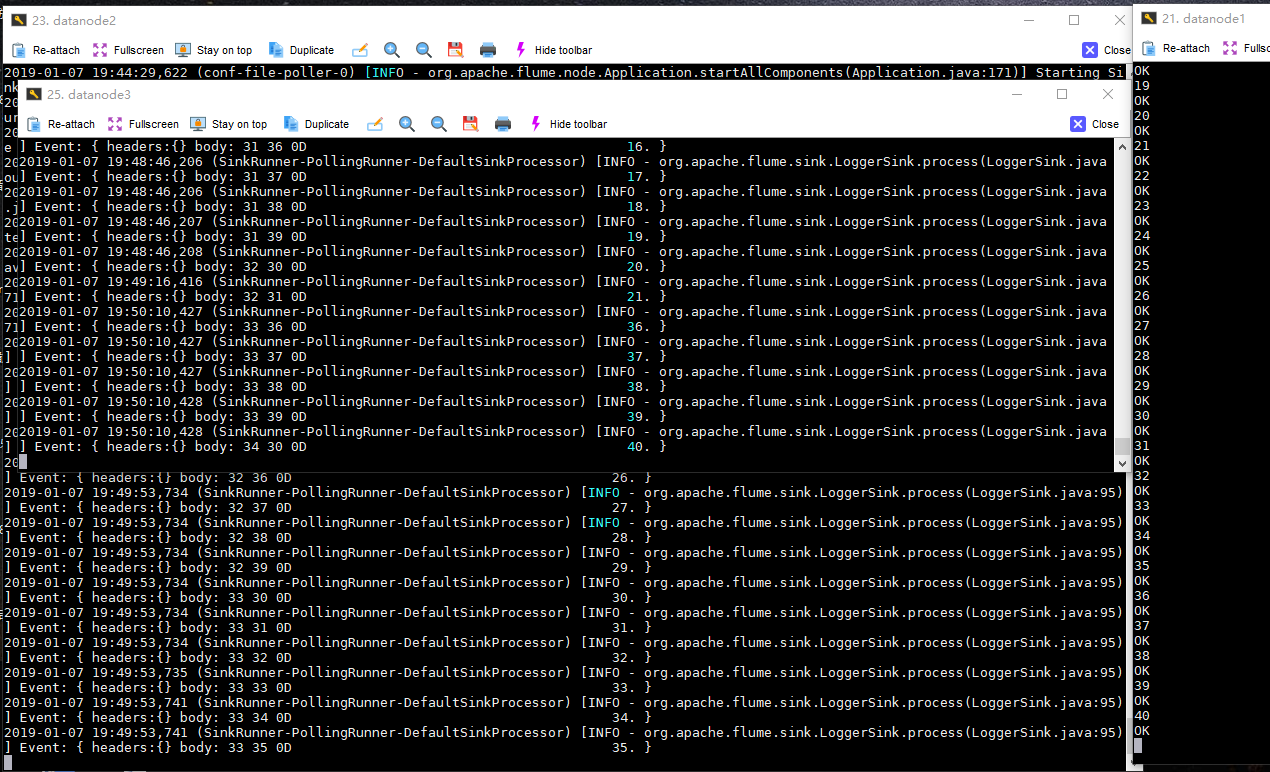
多数据源汇总案例
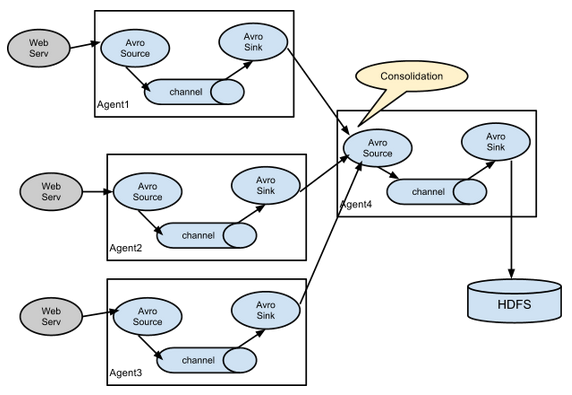
datanode1上的flume-1监控一个软件的log日志,
datanode2上的flume-2监控某一个端口的数据流,
flume-1与flume-2将数据发送给datanode3上的flume-3,flume-3将最终数据打印到控制台
步骤
- 分发flume
[hadoop@datanode2 job]$ mkdir group2 [hadoop@datanode2 job]$ xsync /opt/module/flume/
datanode1配置source用于监控hive.log文件,配置sink输出数据到下一级flume。
# Name the components on this agent a1.sources = r1 a1.sinks = k1 a1.channels = c1 # Describe/configure the source a1.sources.r1.type = exec a1.sources.r1.command = tail -F /opt/module/datas/logs.log a1.sources.r1.shell = /bin/bash -c # Describe the sink a1.sinks.k1.type = avro a1.sinks.k1.hostname = datanode1 a1.sinks.k1.port = 4141 # Describe the channel a1.channels.c1.type = memory a1.channels.c1.capacity = 1000 a1.channels.c1.transactionCapacity = 100 # Bind the source and sink to the channel a1.sources.r1.channels = c1 a1.sinks.k1.channel = c1
启动
[hadoop@datanode3 flume]$ bin/flume-ng agent --conf conf/ --name a3 --conf-file job/group2/flume3.conf -Dflume.root.logger=INFO,console [hadoop@datanode2 flume]$ bin/flume-ng agent --conf conf/ --name a2 --conf-file job/group2/flume2.conf [hadoop@datanode1 flume]$ bin/flume-ng agent --conf conf/ --name a1 --conf-file job/group2/flume1.conf
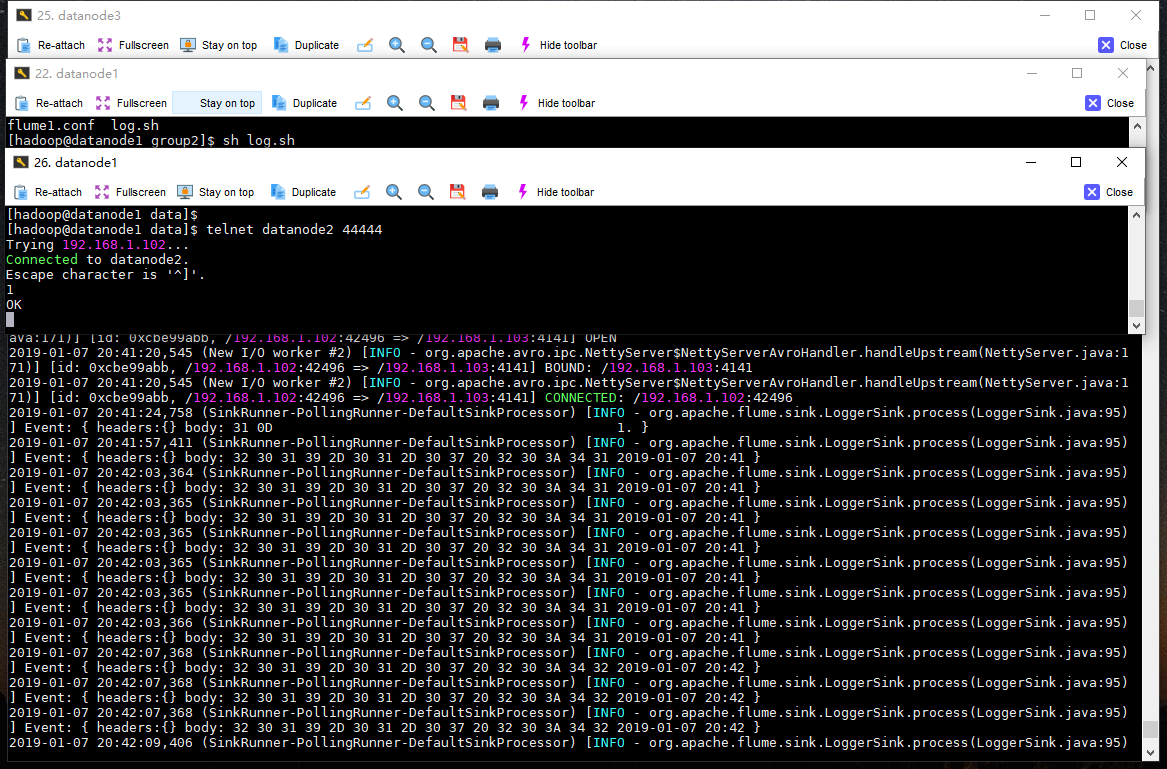
自定义MYSQLSource
SQLSourceHelper
import org.apache.flume.Context;
import org.apache.flume.conf.ConfigurationException;
import org.slf4j.Logger;
import org.slf4j.LoggerFactory;
import java.io.IOException;
import java.sql.*;
import java.text.ParseException;
import java.util.ArrayList;
import java.util.List;
import java.util.Properties;
public class SQLSourceHelper {
private static final Logger LOG = LoggerFactory.getLogger(SQLSourceHelper.class);
private int runQueryDelay, //两次查询的时间间隔
startFrom, //开始id
currentIndex, //当前id
recordSixe = 0, //每次查询返回结果的条数
maxRow; //每次查询的最大条数
private String table, //要操作的表
columnsToSelect, //用户传入的查询的列
customQuery, //用户传入的查询语句
query, //构建的查询语句
defaultCharsetResultSet;//编码集
//上下文,用来获取配置文件
private Context context;
//为定义的变量赋值(默认值),可在flume任务的配置文件中修改
private static final int DEFAULT_QUERY_DELAY = 10000;
private static final int DEFAULT_START_VALUE = 0;
private static final int DEFAULT_MAX_ROWS = 2000;
private static final String DEFAULT_COLUMNS_SELECT = "*";
private static final String DEFAULT_CHARSET_RESULTSET = "UTF-8";
private static Connection conn = null;
private static PreparedStatement ps = null;
private static String connectionURL, connectionUserName, connectionPassword;
//加载静态资源
static {
Properties p = new Properties();
try {
p.load(SQLSourceHelper.class.getClassLoader().getResourceAsStream("jdbc.properties"));
connectionURL = p.getProperty("dbUrl");
connectionUserName = p.getProperty("dbUser");
connectionPassword = p.getProperty("dbPassword");
Class.forName(p.getProperty("dbDriver"));
} catch (IOException | ClassNotFoundException e) {
LOG.error(e.toString());
}
}
//获取JDBC连接
private static Connection InitConnection(String url, String user, String pw) {
try {
Connection conn = DriverManager.getConnection(url, user, pw);
if (conn == null)
throw new SQLException();
return conn;
} catch (SQLException e) {
e.printStackTrace();
}
return null;
}
//构造方法
SQLSourceHelper(Context context) throws ParseException {
//初始化上下文
this.context = context;
//有默认值参数:获取flume任务配置文件中的参数,读不到的采用默认值
this.columnsToSelect = context.getString("columns.to.select", DEFAULT_COLUMNS_SELECT);
this.runQueryDelay = context.getInteger("run.query.delay", DEFAULT_QUERY_DELAY);
this.startFrom = context.getInteger("start.from", DEFAULT_START_VALUE);
this.defaultCharsetResultSet = context.getString("default.charset.resultset", DEFAULT_CHARSET_RESULTSET);
//无默认值参数:获取flume任务配置文件中的参数
this.table = context.getString("table");
this.customQuery = context.getString("custom.query");
connectionURL = context.getString("connection.url");
connectionUserName = context.getString("connection.user");
connectionPassword = context.getString("connection.password");
conn = InitConnection(connectionURL, connectionUserName, connectionPassword);
//校验相应的配置信息,如果没有默认值的参数也没赋值,抛出异常
checkMandatoryProperties();
//获取当前的id
currentIndex = getStatusDBIndex(startFrom);
//构建查询语句
query = buildQuery();
}
//校验相应的配置信息(表,查询语句以及数据库连接的参数)
private void checkMandatoryProperties() {
if (table == null) {
throw new ConfigurationException("property table not set");
}
if (connectionURL == null) {
throw new ConfigurationException("connection.url property not set");
}
if (connectionUserName == null) {
throw new ConfigurationException("connection.user property not set");
}
if (connectionPassword == null) {
throw new ConfigurationException("connection.password property not set");
}
}
//构建sql语句
private String buildQuery() {
String sql = "";
//获取当前id
currentIndex = getStatusDBIndex(startFrom);
LOG.info(currentIndex + "");
if (customQuery == null) {
sql = "SELECT " + columnsToSelect + " FROM " + table;
} else {
sql = customQuery;
}
StringBuilder execSql = new StringBuilder(sql);
//以id作为offset
if (!sql.contains("where")) {
execSql.append(" where ");
execSql.append("id").append(">").append(currentIndex);
return execSql.toString();
} else {
int length = execSql.toString().length();
return execSql.toString().substring(0, length - String.valueOf(currentIndex).length()) + currentIndex;
}
}
//执行查询
List<List<Object>> executeQuery() {
try {
//每次执行查询时都要重新生成sql,因为id不同
customQuery = buildQuery();
//存放结果的集合
List<List<Object>> results = new ArrayList<>();
if (ps == null) {
//
ps = conn.prepareStatement(customQuery);
}
ResultSet result = ps.executeQuery(customQuery);
while (result.next()) {
//存放一条数据的集合(多个列)
List<Object> row = new ArrayList<>();
//将返回结果放入集合
for (int i = 1; i <= result.getMetaData().getColumnCount(); i++) {
row.add(result.getObject(i));
}
results.add(row);
}
LOG.info("execSql:" + customQuery + "
resultSize:" + results.size());
return results;
} catch (SQLException e) {
LOG.error(e.toString());
// 重新连接
conn = InitConnection(connectionURL, connectionUserName, connectionPassword);
}
return null;
}
//将结果集转化为字符串,每一条数据是一个list集合,将每一个小的list集合转化为字符串
List<String> getAllRows(List<List<Object>> queryResult) {
List<String> allRows = new ArrayList<>();
if (queryResult == null || queryResult.isEmpty())
return allRows;
StringBuilder row = new StringBuilder();
for (List<Object> rawRow : queryResult) {
Object value = null;
for (Object aRawRow : rawRow) {
value = aRawRow;
if (value == null) {
row.append(",");
} else {
row.append(aRawRow.toString()).append(",");
}
}
allRows.add(row.toString());
row = new StringBuilder();
}
return allRows;
}
//更新offset元数据状态,每次返回结果集后调用。必须记录每次查询的offset值,为程序中断续跑数据时使用,以id为offset
void updateOffset2DB(int size) {
//以source_tab做为KEY,如果不存在则插入,存在则更新(每个源表对应一条记录)
String sql = "insert into flume_meta(source_tab,currentIndex) VALUES('"
+ this.table
+ "','" + (recordSixe += size)
+ "') on DUPLICATE key update source_tab=values(source_tab),currentIndex=values(currentIndex)";
LOG.info("updateStatus Sql:" + sql);
execSql(sql);
}
//执行sql语句
private void execSql(String sql) {
try {
ps = conn.prepareStatement(sql);
LOG.info("exec::" + sql);
ps.execute();
} catch (SQLException e) {
e.printStackTrace();
}
}
//获取当前id的offset
private Integer getStatusDBIndex(int startFrom) {
//从flume_meta表中查询出当前的id是多少
String dbIndex = queryOne("select currentIndex from flume_meta where source_tab='" + table + "'");
if (dbIndex != null) {
return Integer.parseInt(dbIndex);
}
//如果没有数据,则说明是第一次查询或者数据表中还没有存入数据,返回最初传入的值
return startFrom;
}
//查询一条数据的执行语句(当前id)
private String queryOne(String sql) {
ResultSet result = null;
try {
ps = conn.prepareStatement(sql);
result = ps.executeQuery();
while (result.next()) {
return result.getString(1);
}
} catch (SQLException e) {
e.printStackTrace();
}
return null;
}
//关闭相关资源
void close() {
try {
ps.close();
conn.close();
} catch (SQLException e) {
e.printStackTrace();
}
}
int getCurrentIndex() {
return currentIndex;
}
void setCurrentIndex(int newValue) {
currentIndex = newValue;
}
int getRunQueryDelay() {
return runQueryDelay;
}
String getQuery() {
return query;
}
String getConnectionURL() {
return connectionURL;
}
private boolean isCustomQuerySet() {
return (customQuery != null);
}
Context getContext() {
return context;
}
public String getConnectionUserName() {
return connectionUserName;
}
public String getConnectionPassword() {
return connectionPassword;
}
}
SQLSource
| 属性 | 说明(括号中为默认值) |
|---|---|
| runQueryDelay | 查询时间间隔(10000) |
| batchSize | 缓存大小(100) |
| startFrom | 查询语句开始id(0) |
| currentIndex | 查询语句当前id,每次查询之前需要查元数据表 |
| recordSixe | 查询返回条数 |
| table | 监控的表名 |
| columnsToSelect | 查询字段(*) |
| customQuery | 用户传入的查询语句 |
| query | 查询语句 |
| defaultCharsetResultSet | 编码格式(UTF-8) |
import org.apache.flume.Context;
import org.apache.flume.Event;
import org.apache.flume.EventDeliveryException;
import org.apache.flume.PollableSource;
import org.apache.flume.conf.Configurable;
import org.apache.flume.event.SimpleEvent;
import org.apache.flume.source.AbstractSource;
import org.slf4j.Logger;
import org.slf4j.LoggerFactory;
import java.text.ParseException;
import java.util.ArrayList;
import java.util.HashMap;
import java.util.List;
public class SQLSource extends AbstractSource implements Configurable, PollableSource {
//打印日志
private static final Logger LOG = LoggerFactory.getLogger(SQLSource.class);
//定义sqlHelper
private SQLSourceHelper sqlSourceHelper;
@Override
public long getBackOffSleepIncrement() {
return 0;
}
@Override
public long getMaxBackOffSleepInterval() {
return 0;
}
@Override
public void configure(Context context) {
try {
//初始化
sqlSourceHelper = new SQLSourceHelper(context);
} catch (ParseException e) {
e.printStackTrace();
}
}
@Override
public Status process() throws EventDeliveryException {
try {
//查询数据表
List<List<Object>> result = sqlSourceHelper.executeQuery();
//存放event的集合
List<Event> events = new ArrayList<>();
//存放event头集合
HashMap<String, String> header = new HashMap<>();
//如果有返回数据,则将数据封装为event
if (!result.isEmpty()) {
List<String> allRows = sqlSourceHelper.getAllRows(result);
Event event = null;
for (String row : allRows) {
event = new SimpleEvent();
event.setBody(row.getBytes());
event.setHeaders(header);
events.add(event);
}
//将event写入channel
this.getChannelProcessor().processEventBatch(events);
//更新数据表中的offset信息
sqlSourceHelper.updateOffset2DB(result.size());
}
//等待时长
Thread.sleep(sqlSourceHelper.getRunQueryDelay());
return Status.READY;
} catch (InterruptedException e) {
LOG.error("Error procesing row", e);
return Status.BACKOFF;
}
}
@Override
public synchronized void stop() {
LOG.info("Stopping sql source {} ...", getName());
try {
//关闭资源
sqlSourceHelper.close();
} finally {
super.stop();
}
}
}
| SQLSourceHelper(Context context) | 构造方法,初始化属性及获取JDBC连接 |
|---|---|
| InitConnection(String url, String user, String pw) | 获取JDBC连接 |
| checkMandatoryProperties() | 校验相关属性是否设置(实际开发中可增加内容) |
| buildQuery() | 根据实际情况构建sql语句,返回值String |
| executeQuery() | 执行sql语句的查询操作,返回值List> |
| getAllRows(List> queryResult) | 将查询结果转换为String,方便后续操作 |
| updateOffset2DB(int size) | 根据每次查询结果将offset写入元数据表 |
| execSql(String sql) | 具体执行sql语句方法 |
| getStatusDBIndex(int startFrom) | 获取元数据表中的offset |
| queryOne(String sql) | 获取元数据表中的offset实际sql语句执行方法 |
| close() | 关闭资源 |
测试准备
驱动包
[hadoop@datanode1 flume]$ cp /opt/sorfware/mysql-libs/mysql-connector-java-5.1.27/mysql-connector-java-5.1.27-bin.jar /opt/module/flume/lib/
打包项目并将jar放入flume的lib目录下
配置文件
[hadoop@datanode1 flume]$ vim job/mysql.conf # Name the components on this agent a1.sources = r1 a1.sinks = k1 a1.channels = c1 # Describe/configure the source a1.sources.r1.type = com.hph.SQLSource a1.sources.r1.connection.url = jdbc:mysql://192.168.1.101:3306/mysqlsource a1.sources.r1.connection.user = root a1.sources.r1.connection.password = 123456 a1.sources.r1.table = student a1.sources.r1.columns.to.select = * a1.sources.r1.incremental.column.name = id a1.sources.r1.incremental.value = 0 a1.sources.r1.run.query.delay=5000 # Describe the sink a1.sinks.k1.type = logger # Describe the channel a1.channels.c1.type = memory a1.channels.c1.capacity = 1000 a1.channels.c1.transactionCapacity = 100 # Bind the source and sink to the channel a1.sources.r1.channels = c1 a1.sinks.k1.channel = c1
Mysql表准备
CREATE TABLE `student` ( `id` int(11) NOT NULL AUTO_INCREMENT, `name` varchar(255) NOT NULL, PRIMARY KEY (`id`) ); CREATE TABLE `flume_meta` ( `source_tab` varchar(255) NOT NULL, `currentIndex` varchar(255) NOT NULL, PRIMARY KEY (`source_tab`) );
测试脚本
#!/bin/bash
HOSTNAME="192.168.1.101" #数据库信息
PORT="3306"
USERNAME="root"
PASSWORD="123456"
DBNAME="mysqlsource" #数据库名称
TABLENAME="student" #数据库中表的名称
i=0
while [true]
let i+=1;
do
insert_sql="insert into ${TABLENAME}(id,name) values($i,'student$i')"
mysql -h${HOSTNAME} -P${PORT} -u${USERNAME} -p${PASSWORD} ${DBNAME} -e "${insert_sql}"
sleep 5
done
测试并查看
[hadoop@datanode1 flume]$ bin/flume-ng agent --conf conf/ --name a1 --conf-file job/mysql.conf -Dflume.root.logger=INFO,console #启动agent [hadoop@datanode1 job]$ sh mysql.sh #启动测试脚本

Flume监控Ganglia
步骤
1.安装httpd服务与php
[hadoop@datanode1 flume]$ sudo yum -y install httpd php
- 安装其他依赖
[hadoop@datanode1 flume]$ sudo yum -y install rrdtool perl-rrdtool rrdtool-devel [hadoop@datanode1 flume]$ sudo yum -y install apr-devel
安装ganglia
[hadoop@datanode1 flume]$ sudo rpm -Uvh http://dl.fedoraproject.org/pub/epel/6/x86_64/epel-release-6-8.noarch.rpm [hadoop@datanode1 flume]$ sudo yum -y install ganglia-gmetad [hadoop@datanode1 flume]$ sudo yum -y install ganglia-web [hadoop@datanode1 flume]$ sudo yum install -y ganglia-gmond
-
修改ganglia
[hadoop@datanode1 flume]$ sudo vim /etc/httpd/conf.d/ganglia.conf # Ganglia monitoring system php web frontend Alias /ganglia /usr/share/ganglia <Location /ganglia> Order deny,allow Deny from all Allow from all # Allow from 127.0.0.1 # Allow from ::1 # Allow from .example.com </Location>
修改配置文件gmetad.conf
data_source "datanode1" 192.168.1.101
修改配置文件gmond.conf
cluster {
name = "datanode1" #自己的主机名
owner = "unspecified"
latlong = "unspecified"
url = "unspecified"
}
udp_send_channel {
#bind_hostname = yes # Highly recommended, soon to be default.
# This option tells gmond to use a source address
# that resolves to the machine's hostname. Without
# this, the metrics may appear to come from any
# interface and the DNS names associated with
# those IPs will be used to create the RRDs.
#mcast_join = 239.2.11.71 #注释掉
host=192.168.1.101 #自己的主机IP
port = 8649 #端口号
ttl = 1
}
修改配置文件config
[hadoop@datanode1 flume]$ sudo vim /etc/selinux/config # This file controls the state of SELinux on the system. # SELINUX= can take one of these three values: # enforcing - SELinux security policy is enforced. # permissive - SELinux prints warnings instead of enforcing. # disabled - No SELinux policy is loaded. SELINUX=disabled # SELINUXTYPE= can take one of these two values: # targeted - Targeted processes are protected, # mls - Multi Level Security protection. SELINUXTYPE=targeted
注意selinux本次生效关闭必须重启,如果此时不想重启,可以临时生效之:
[hadoop@datanode1 flume]$ sudo setenforce 0
启动ganglia
[hadoop@datanode1 flume]$ sudo service httpd start Starting httpd: [hadoop@datanode1 flume]$ sudo service gmetad start [hadoop@datanode1 flume]$ sudo service gmond start [hadoop@datanode1 flume]$
如果完成以上操作依然出现权限不足错误,请修改/var/lib/ganglia目录的权限
[hadoop@datanode1 flume]$ sudo chmod -R 777 /var/lib/ganglia
操作Flume测试监控
1.修改/opt/module/flume/conf目录下的flume-env.sh配置:
[hadoop@datanode1 conf]$ vim flume-env.sh JAVA_OPTS="-Dflume.monitoring.type=ganglia -Dflume.monitoring.hosts=192.168.1.101:8649 -Xms100m -Xmx200m" [hadoop@datanode1 conf]$ xsync flume-env.sh
启动flume任务
[hadoop@datanode3 flume]$ bin/flume-ng agent --conf conf/ --name a3 --conf-file job/group2/flume3.conf -Dflume.root.logger=INFO,console [hadoop@datanode2 flume]$ bin/flume-ng agent --conf conf/ --name a2 --conf-file job/group2/flume2.conf [hadoop@datanode1 flume]$ bin/flume-ng agent --conf conf/ --name a1 --conf-file job/group2/flume1.conf
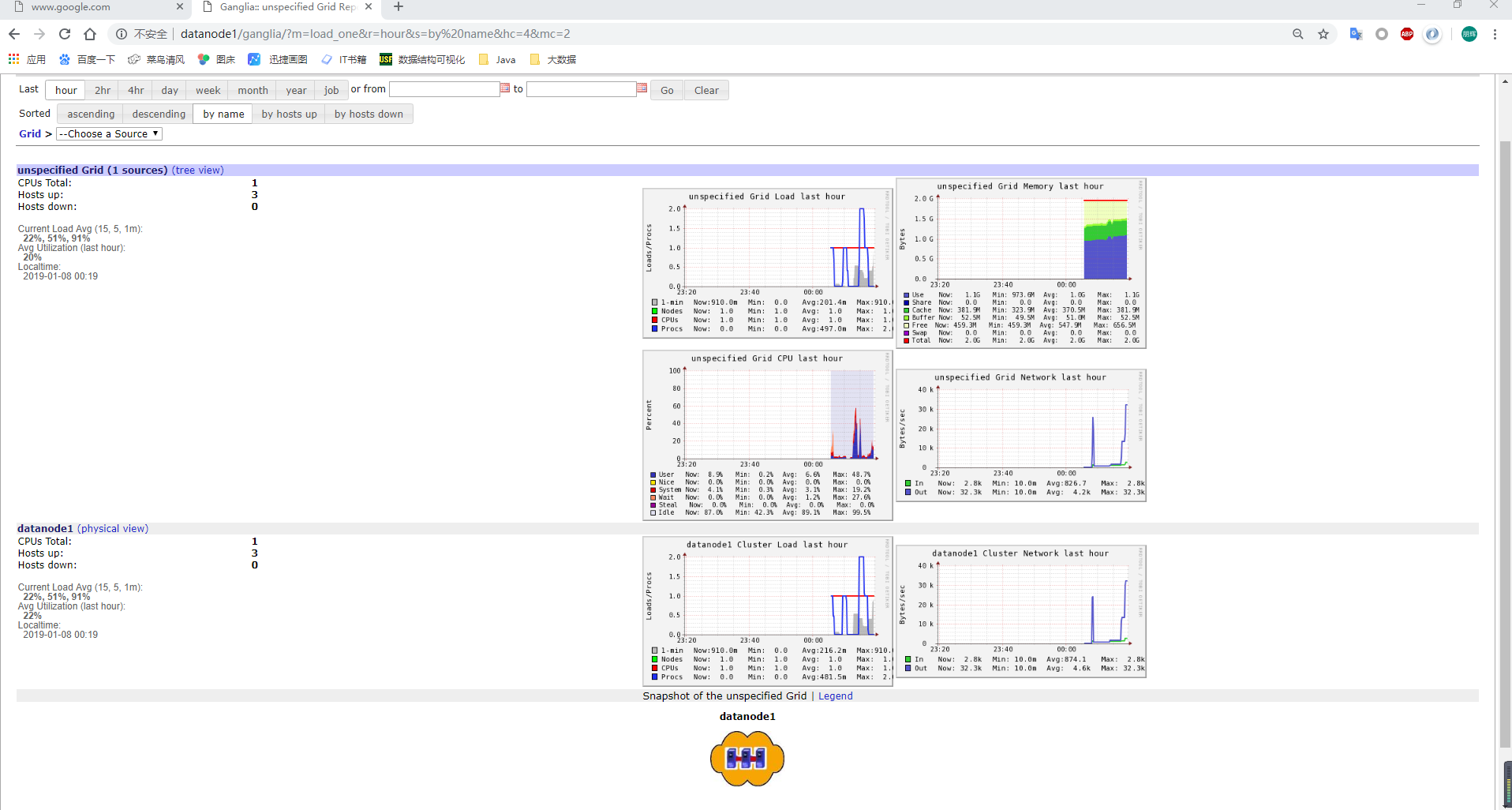

| 字段(图表名称) | 字段含义 |
|---|---|
| EventPutAttemptCount | source尝试写入channel的事件总数量 |
| EventPutSuccessCount | 成功写入channel且提交的事件总数量 |
| EventTakeAttemptCount | sink尝试从channel拉取事件的总数量。这不意味着每次事件都被返回,因为sink拉取的时候channel可能没有任何数据。 |
| EventTakeSuccessCount | sink成功读取的事件的总数量 |
| StartTime | channel启动的时间(毫秒) |
| StopTime | channel停止的时间(毫秒) |
| ChannelSize | 目前channel中事件的总数量 |
| ChannelFillPercentage | channel占用百分比 |
| ChannelCapacity | channel的容量 |